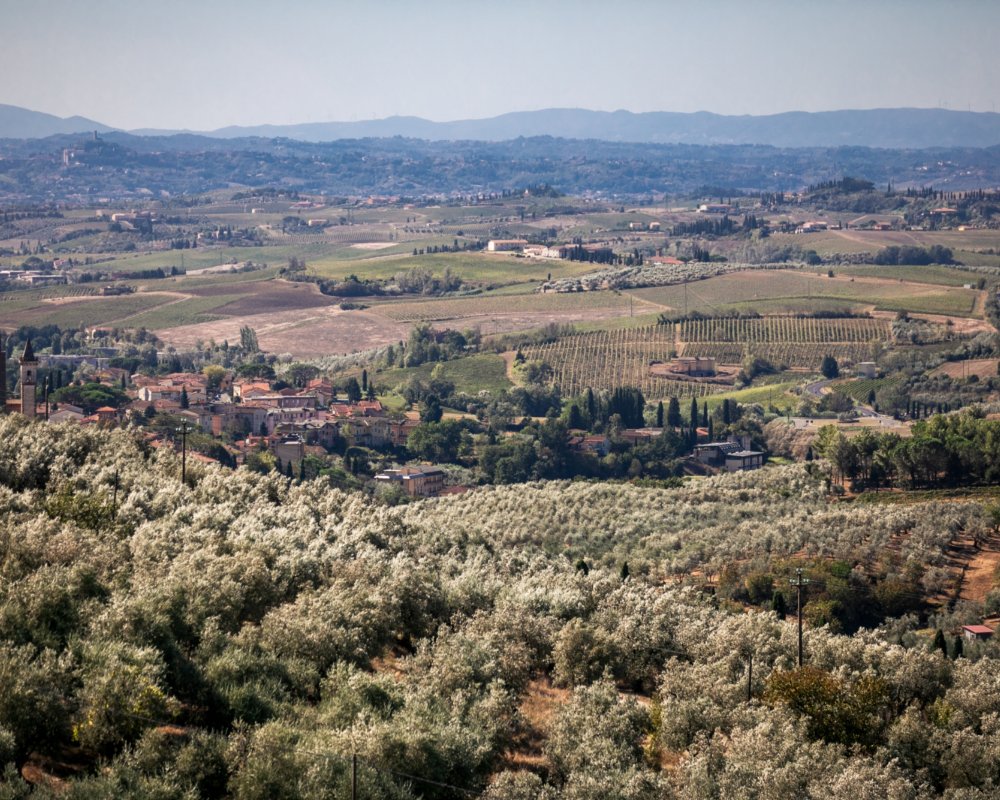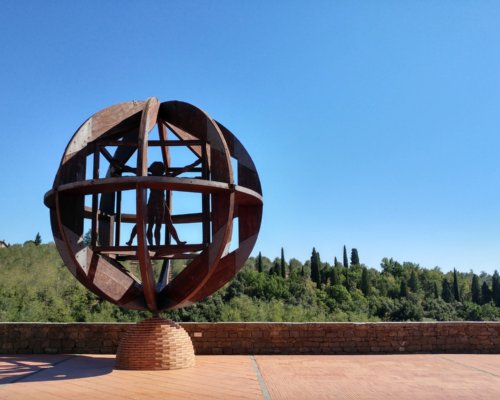Exploring Leonardo da Vinci's hometown
Known worldwide for being the birthplace of the greatest genius of the Italian Renaissance, Vinci is a perfect place to spend a day full of culture and to explore Tuscan endless vineyards and olive groves, pretty much the same as in Leonardo's time.
Vinci is situated in the hills of Montalbano, a green area divided between Pistoia, Prato and Florence area. The town offers plenty of things to see and many of them are related to Leonardo’s life: the house where he was born, just 3 kilometres from Vinci in the middle of the countryside, the church where he was baptised, the museum that collects his models and machines and the documentation center.
Vinci dates back to the early middle ages, when this area was under the rule of the Guidi counts. In the town centre you’ll find the Guidi castle, also known as the "castle of the ship" because of its elongated shape and the tower seems like a sailing vessel. Since 1953 it holds the second part of the Museo Leonardiano with one of the largest collections in the world of Leonardo's models, reconstructed on the basis of his precious drawings. More than 300 works and objects are on display including his war machines and flying artifacts.
Start your journey at Palazzina Uzielli (where you'll find also the ticket office and the beginning of the museum exhibition route). If you are traveling with your children you can book a guided trail or an educational workshop for the whole family. Don't miss the wooden representation of the Vitruvian Man (the famous drawing by Leonardo in which he represented a man with the ideal proportions) which is situated behind the castle in a terrace overviewing the valley: a perfect place to take a picture of the surrounding countryside. There you'll find a statue dedicated to Leonardo, called L’Uomo di Vinci. It was made by Mario Ceroli and donated to the town by the artist in 1987. Today it represents the symbol of Vinci.
Vinci dates back to the early middle ages, when this area was under the rule of the Guidi counts. In the town centre you’ll find the Guidi castle, also known as the "castle of the ship" because of its elongated shape and the tower seems like a sailing vessel. Since 1953 it holds the second part of the Museo Leonardiano with one of the largest collections in the world of Leonardo's models, reconstructed on the basis of his precious drawings. More than 300 works and objects are on display including his war machines and flying artifacts.
Start your journey at Palazzina Uzielli (where you'll find also the ticket office and the beginning of the museum exhibition route). If you are traveling with your children you can book a guided trail or an educational workshop for the whole family. Don't miss the wooden representation of the Vitruvian Man (the famous drawing by Leonardo in which he represented a man with the ideal proportions) which is situated behind the castle in a terrace overviewing the valley: a perfect place to take a picture of the surrounding countryside. There you'll find a statue dedicated to Leonardo, called L’Uomo di Vinci. It was made by Mario Ceroli and donated to the town by the artist in 1987. Today it represents the symbol of Vinci.
Continue your exploration at the church of Santa Croce, built in the 13th century and later reworked in neo-Renaissance style. It holds the baptismal font where Leonardo da Vinci is said to have been baptised. The interior is simple, on the walls you’ll find paintings by Leonardo da Vinci and other artists from the area. Not far from the church is Piazza dei Guidi, a square designed by the artist Mimmo Paladino, who was inspired both by Leonardo as a scientist as well as an artist to create a new urban space. You’ll find drawings, statues, works of art… Go there for a break and see for yourself: it’s hard to explain!
If you stop for lunch in Vinci don’t miss the opportunity to taste the specialties of the Montalbano area like the Toscano IGP extra virgin olive oil and the Carmignano DOCG wine together with some Tuscan specialties like pappa al pomodoro or some local cold cuts.
Continue your exploration at the church of Santa Croce, built in the 13th century and later reworked in neo-Renaissance style. It holds the baptismal font where Leonardo da Vinci is said to have been baptised. The interior is simple, on the walls you’ll find paintings by Leonardo da Vinci and other artists from the area. Not far from the church is Piazza dei Guidi, a square designed by the artist Mimmo Paladino, who was inspired both by Leonardo as a scientist as well as an artist to create a new urban space. You’ll find drawings, statues, works of art… Go there for a break and see for yourself: it’s hard to explain!
If you stop for lunch in Vinci don’t miss the opportunity to taste the specialties of the Montalbano area like the Toscano IGP extra virgin olive oil and the Carmignano DOCG wine together with some Tuscan specialties like pappa al pomodoro or some local cold cuts.
After lunch go on a cultural pilgrimage to Leonardo’s birth house. The Casa Natale di Leonardo (the birthplace of Leonardo da Vinci) is situated 3 km far from Vinci, in Anchiano. You can reach it by car or on foot by following the Sentiero Verde, an easy walk path that connects Vinci to Anchiano through vineyards and olive groves.
The route begins on the north side of the village on the paved road that passes alongside the Mulino della Doccia, mentioned by Leonardo da Vinci in the Codex Atlanticus. The Leonardo da Vinci house is a farmhouse featuring some reproductions of his drawings and a life-sized hologram of the artist himself speaking about the events of his life and work.
After lunch go on a cultural pilgrimage to Leonardo’s birth house. The Casa Natale di Leonardo (the birthplace of Leonardo da Vinci) is situated 3 km far from Vinci, in Anchiano. You can reach it by car or on foot by following the Sentiero Verde, an easy walk path that connects Vinci to Anchiano through vineyards and olive groves.
The route begins on the north side of the village on the paved road that passes alongside the Mulino della Doccia, mentioned by Leonardo da Vinci in the Codex Atlanticus. The Leonardo da Vinci house is a farmhouse featuring some reproductions of his drawings and a life-sized hologram of the artist himself speaking about the events of his life and work.

